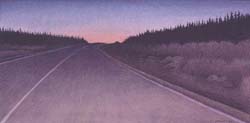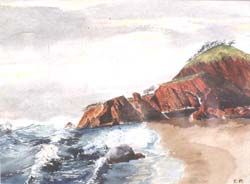|
 The
landscape of Newfoundland and Labrador is as distinctive as its people.
From rocky cliffs to vast oceans, from lush meadows to sprawling barrens,
it is a widely varied thing and has been described as both uninhabitable
and life giving. Through his art, Christopher Pratt has managed to capture
an essence of the place. The
landscape of Newfoundland and Labrador is as distinctive as its people.
From rocky cliffs to vast oceans, from lush meadows to sprawling barrens,
it is a widely varied thing and has been described as both uninhabitable
and life giving. Through his art, Christopher Pratt has managed to capture
an essence of the place.
Pratt's landscape art has conveyed his immediate surroundings to the rest
of the world and has been rendered in each medium he uses. The choice
of subject is influenced, to a large degree, by Pratt's love of his home.
He says, "Spiritually, I am so attached to my environment that if
I ever had to leave Newfoundland, this house, I feel I could somehow return,
walk up the river on the other side and, looking over, find myself still
here, standing at this window. That feeling fascinates and frightens me."
Whether the landscape subject is a clothesline strung between a pole and
a house, white sheets flapping in the wind
Clothesline (1965), a sheep lying peacefully alongside a fence in
St. Mary's Bay The
Sheep (1971) or a road stretching off into the sunset Road
Between Night and Day: Winter Road (1993), Pratt's love for his home
province shines through in his work.
One of the most common features of Pratt's landscape work is the presence
of the ocean. Newfoundland and Labrador has almost always been associated
with the sea that surrounds and shapes it, and this association is obvious
in his art. It may be the focal point of the work Labrador Sea
(1982) or it may be quietly lurking in the background Sunday
Afternoon (1972). In fact, Pratt goes so far as to say  "The
sea is almost always present in my work, even when it isn't seen. I know
it is there behind the hill." Much like many Newfoundlanders who
find after moving away that the thing they miss most is the crash of the
North Atlantic, the sea is in Pratt's thoughts, even if the water itself
is not seen in his paintings. "The
sea is almost always present in my work, even when it isn't seen. I know
it is there behind the hill." Much like many Newfoundlanders who
find after moving away that the thing they miss most is the crash of the
North Atlantic, the sea is in Pratt's thoughts, even if the water itself
is not seen in his paintings.
Pratt sometimes uses landscape to explore the notion of time and space.
The wide fields and open seas can be seen to represent freedom, and distance
to represent time. There is a sense that there is no end to the space,
and no limit to what can be done in that space. This feeling is especially
strong in works like
Bay (1972), where the only thing that
separates the sea and the open sky is a thin horizon line.
Like his other works, Pratt's landscapes are based on his memories of
places and things that he has seen over the course of his life. These
too are abstracted and generalised. While a painting may contain houses
and headlands of the Southern Avalon Peninsula, they could be in any number
of different places.
return to subjects
|


